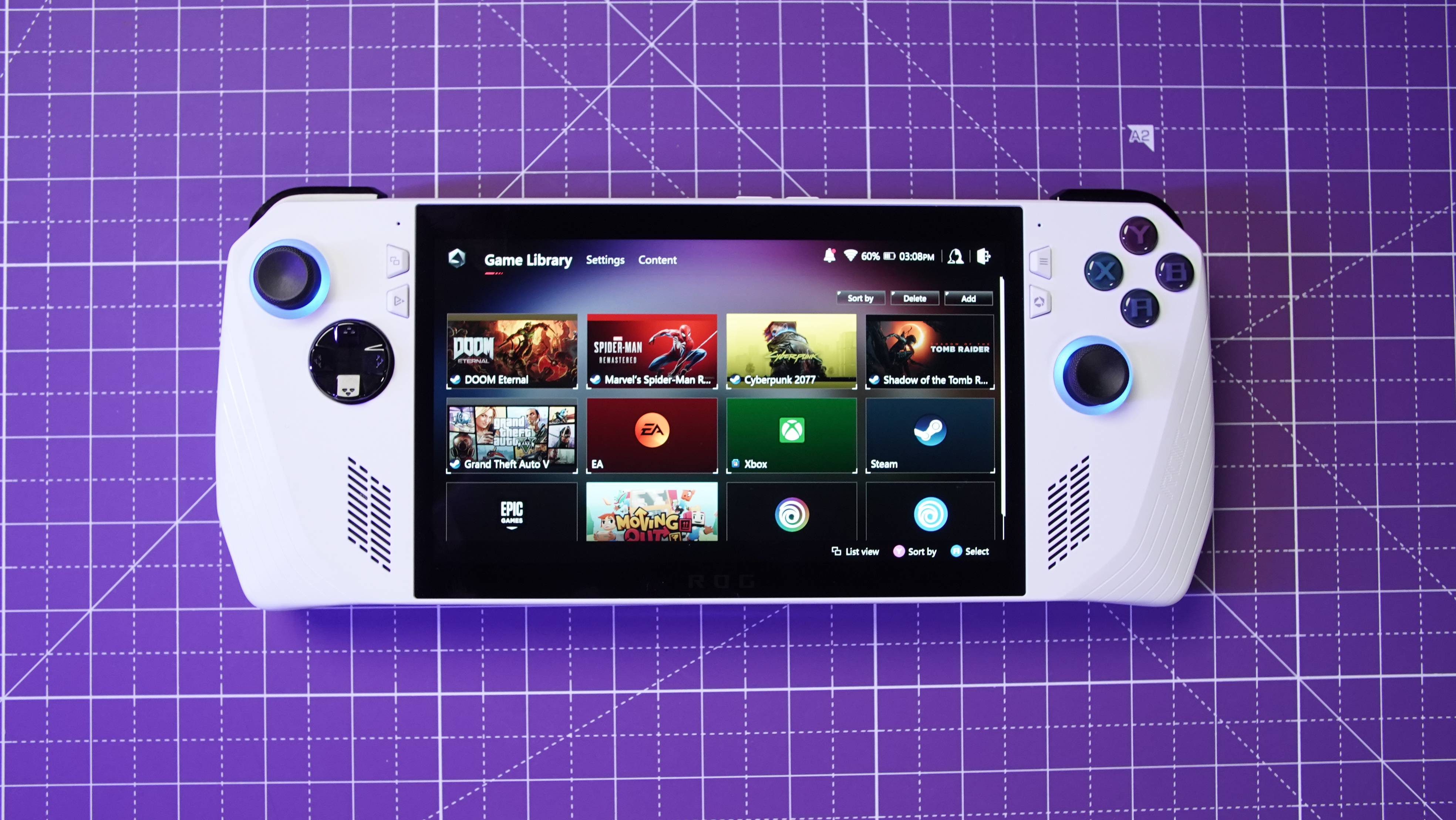
The Asus ROG Ally ($699) is here to take on the Steam Deck. This 7-inch Windows 11 handheld boasts a 120Hz display and a powerful new Zen 4-based AMD APU. Toss in official support from Xbox and the ability to play any Windows-compatible game out of the box, and the ROG Ally should theoretically decimate Valve’s portable gaming device. However, better specs on paper don’t always make for a better gaming experience.
I’ve tested the ROG Ally for the better part of a week and have been impressed by what it offers. The 1080p display delivers sharp visuals and a smooth refresh rate. Games can also run at 60 frames per second and above thanks to the new Ryzen Z1 Extreme processor. On top of that, the handheld’s ergonomic design makes it a pleasure to hold — not to mention comfortable to use for long stretches of time. There’s a lot to like about the ROG Ally.
Despite its virtues, the Asus ROG Ally isn’t the Steam Deck killer many like myself thought it could be. Yes, it has a sharper display and a faster processor, but the gains from these are arguably negligible — especially when you have to run games at 720p to get nominally better performance. Worst of all is the lack of a dedicated user interface like SteamOS. The Asus Armoury Crate app does a decent enough job of gathering games in one spot, but it’s nowhere near as intuitive or functional as Valve’s operating system.
The Asus ROG Ally isn’t a complete disappointment, but I won’t ditch the Steam Deck for it any time soon. Read my full review to find out what makes Asus’ Windows 11 handheld great and what prevents it from reaching its full potential.
Asus ROG Ally review: Specs
Asus ROG Ally review: Price and availability
- Priced at $699
- Numerous compatible accessories
The Asus ROG Ally is now available to pre-order from Best Buy for $699 and will launch on June 13. This configuration packs a 7-inch 120Hz 1080p LCD display, an AMD Ryzen Z1 Extreme APU, 16GB of RAM and 512GB of SSD storage. It also comes with a voucher for 3 free months of PC Xbox Game Pass.
A number of accessories are available for the ROG Ally, including the Asus ROG Ally travel case ($39) and Asus ROG charger dock ($64). The handheld is also compatible with other Asus products, including the ROG Cetra True Wireless earbuds ($99) and the Asus ROG Raikiri Pro controller ($169).
Lastly, the Ally works with the Asus ROG XG mobile external GPU. Packing an Nvidia RTX 4090 laptop GPU and a ton of ports, this device is meant to give the handheld a serious boost in power. Unfortunately, this peripheral costs an eye-watering $1,999 on its own.
A $599 configuration with an AMD Ryzen Z1 chip is also listed on Best Buy. Asus says this model will arrive sometime in Q3 2023.
Asus ROG Ally review: Design
- Sleek, all-white chassis
- Light weight
The ROG Ally has a striking all-white design that distinguishes it from the all-black Steam Deck. RGB lighting under the two analog sticks stands out nicely against the white chassis. The front air vents are strategically placed near the bottom and direct your eyes toward the screen, which is a nice touch.
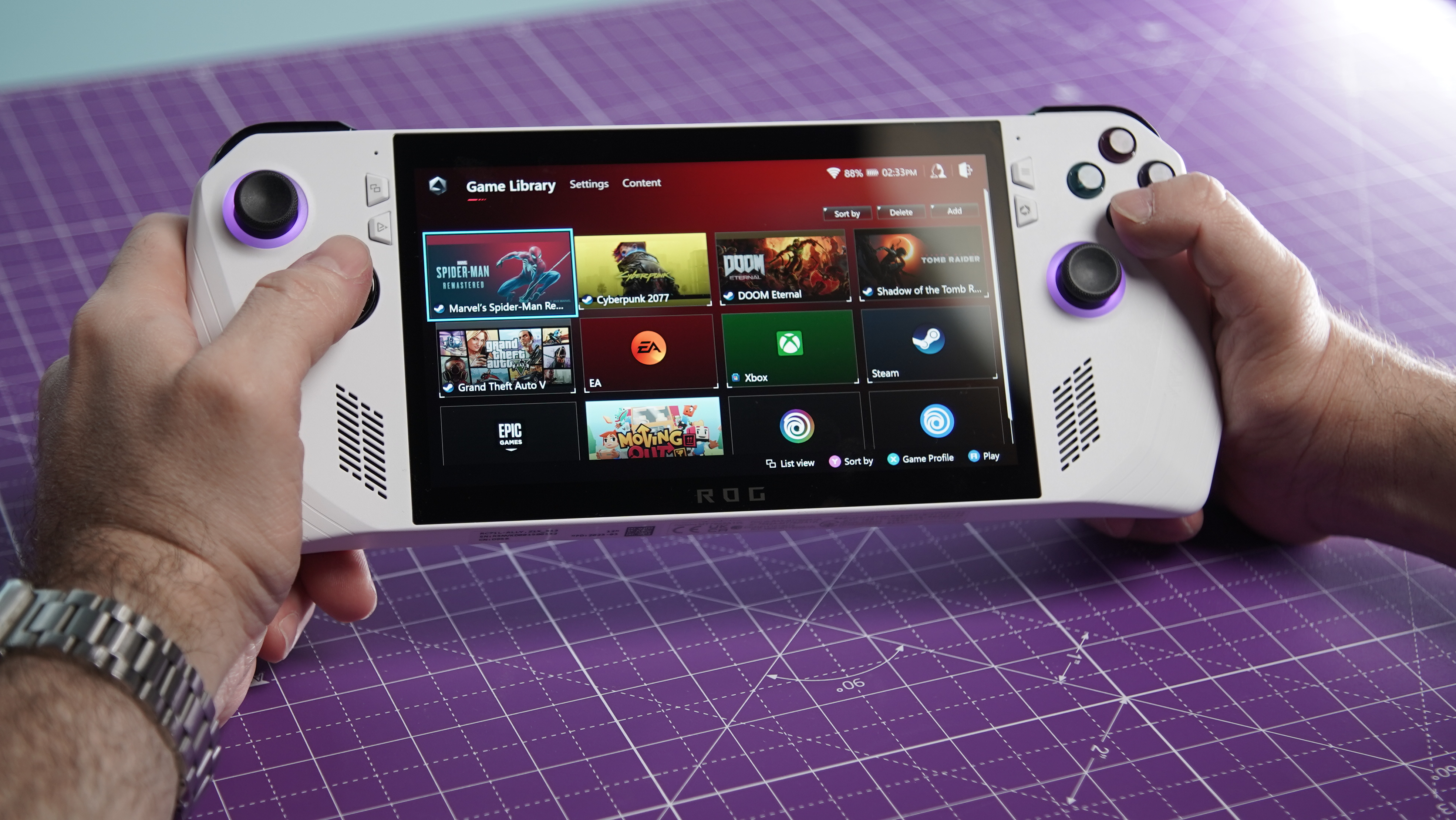
The handheld is great to hold thanks to its light weight and even weight distribution. Its sturdiness makes it feel like a premium product. Using the analog sticks and pressing buttons feels as natural as using a game controller.
Design-wise, the Ally shares similarities to the Nintendo Switch and Steam Deck. On the left side, you’ll find an analog stick and a D-pad. On the right, you’ll find the face buttons and another analog stick (at an offset angle). Each side has two vents and two buttons for navigating the user interface.
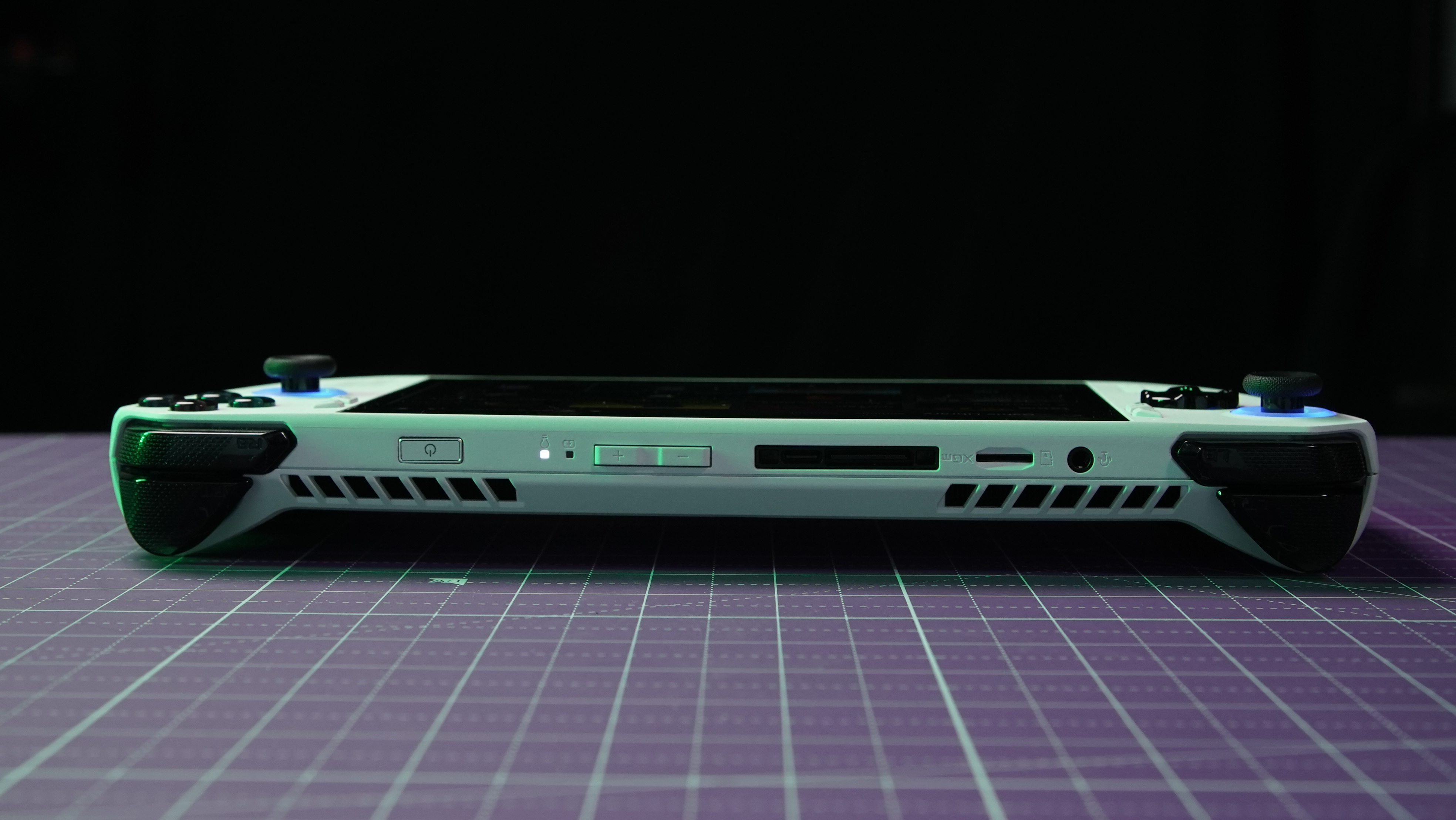
Along the top, there are power and volume buttons, a PCIe port to connect to the ROG XG Mobile external GPU, a USB-C port, a mini SD card reader and a headphone jack. There are also more air vents up top. Lastly, there are two buttons on the handheld’s back and more air vents.
The ROG Ally measures 11.0 x 4.4 x 0.5 inches and weighs 1.3 pounds. In contrast, the Steam Deck measures 11.73 x 4.60 x 1.93 inches and weighs 1.5 pounds. Overall, Asus' handheld is smaller and weighs less than the Steam Deck. Because it’s so light, I found it easy to hold and use the handheld for hours at a time.
Asus ROG Ally review: Display
- Sharp 1080p display
- Smooth 120Hz refresh rate
The ROG Ally has a 7-inch 120Hz 16:9 display with a resolution of 1920 x 1080. I didn’t think I’d be able to tell the difference between 720p and 1080p on a 7-inch display but I’m happy to say I was wrong. Games look phenomenal on this display because of the higher resolution.
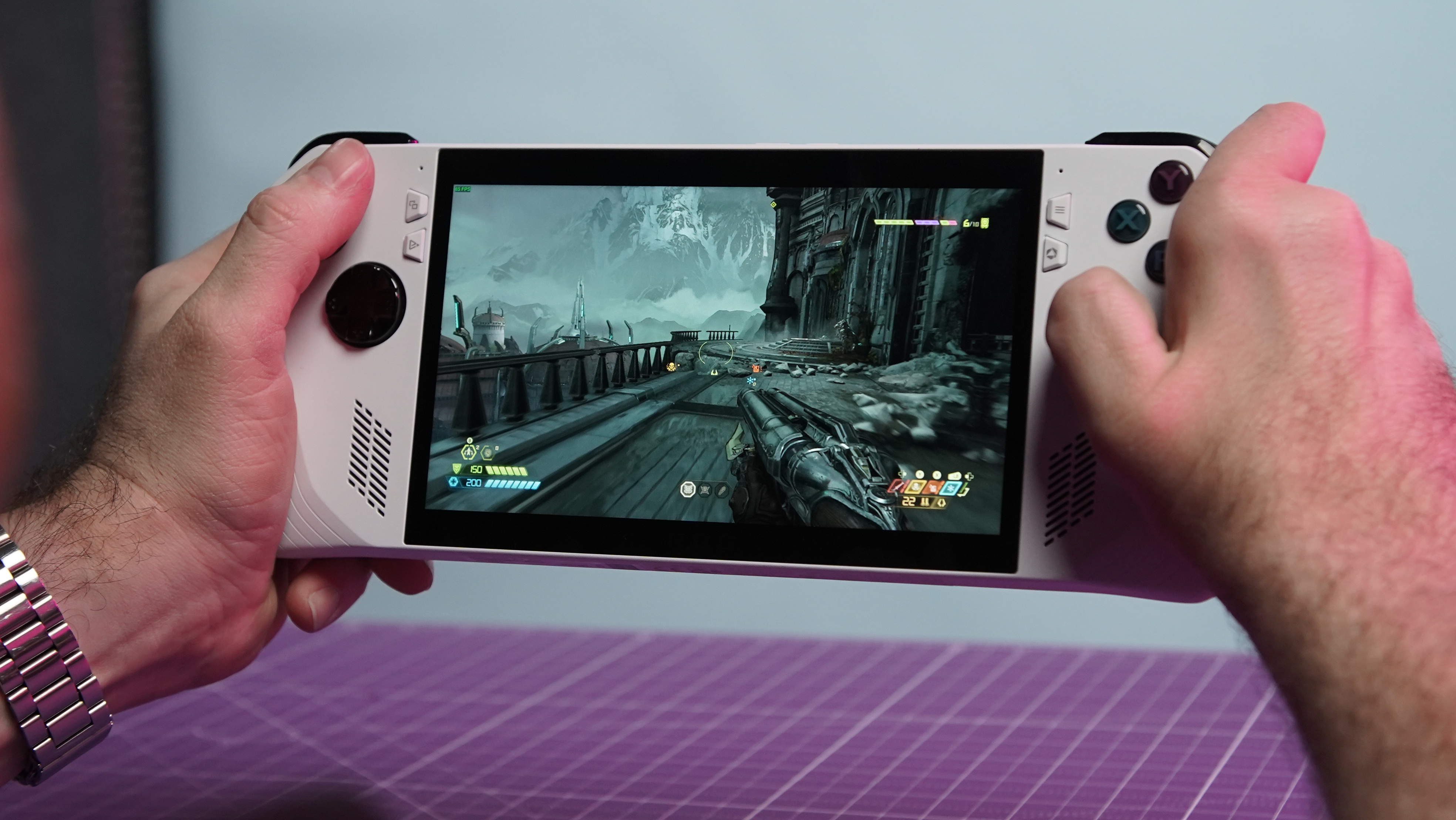
Doom Eternal is a stunner on the ROG Ally. Despite the comparatively small screen size, I had no trouble seeing fine detail in the environments. Far-off objects were just as visible as those closer to the foreground. The same was true for Cyberpunk 2077 and Marvel’s Spider-Man, both of which feature densely-packed urban streets and towering skyscrapers. The ray tracing on these titles was also impressive.
That was my experience — but how did the ROG Ally do in our lab tests? When we pointed our trusty Klein-10A colorimeter at the handheld, we found that its display achieved an average of 465 nits of brightness. That’s not far off from the advertised 500 nits of brightness. It’s also far brighter than the comparatively dim 169.7 nits the Steam Deck achieved in the same test.
As far as color reproduction goes, the ROG Ally delivered 108.6% of the sRGB color gamut and 76.9% of the DCI-P3 color gamut (closer to 100% is best) with a Delta-E score of 0.17 (closer to 0 is best). In comparison, the Steam Deck’s display achieved 68.5% of the sRGB color gamut and registered 48% of the DCI-P3 color gamut, with a Delta-E of 0.25.
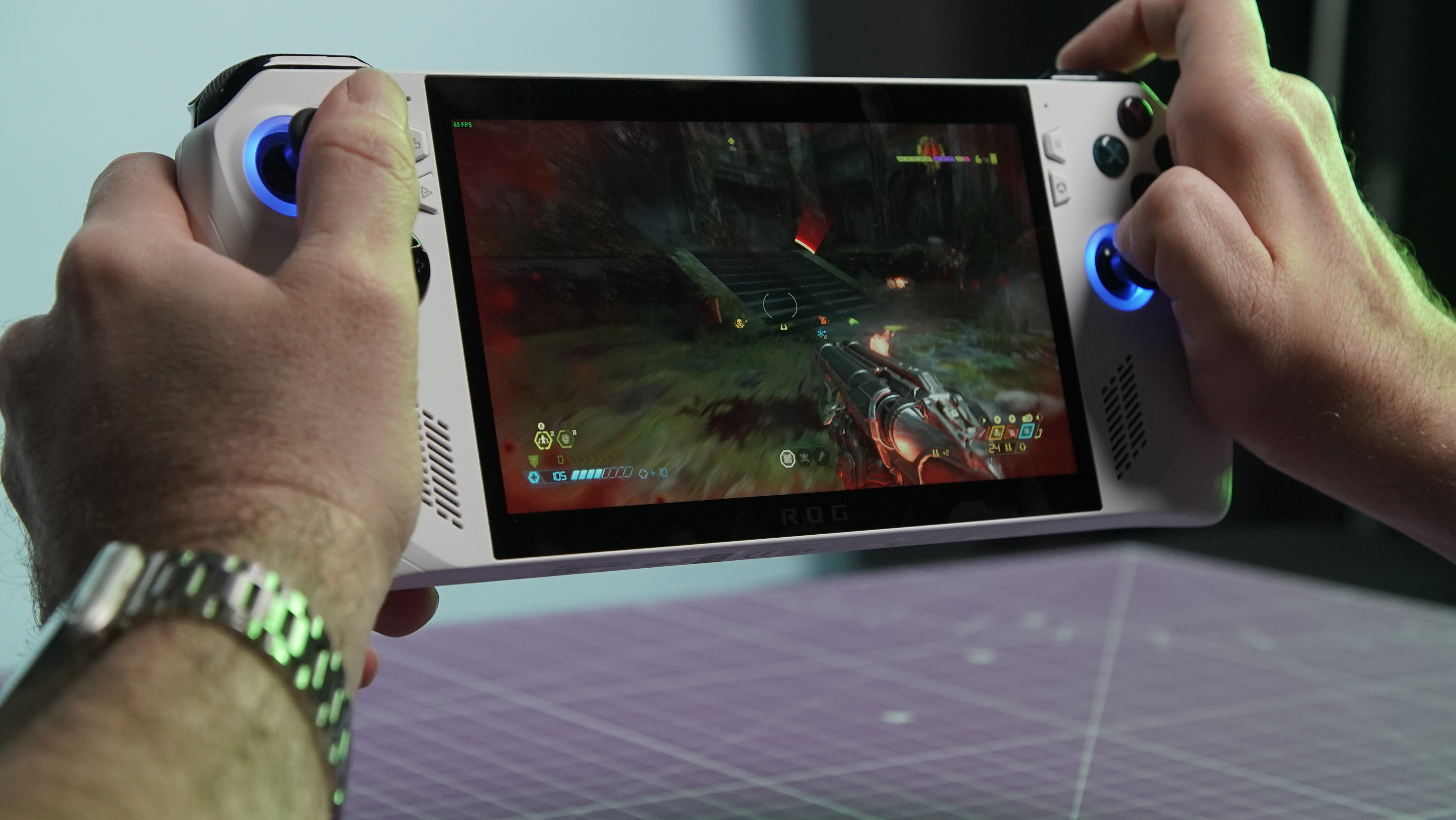
As both our testing and my hands-on experience show, the ROG Ally boasts a bright and vibrant display that helps draw you into whatever game you’re playing. It’s one of this handheld’s best features by far.
Asus ROG Ally review: Performance
- Solid performance at 720p
- Middling frame rates at 1080p
While I was more than impressed with the ROG Ally’s display, I can’t say the same thing about its performance. Don’t get me wrong, games run great on the handheld thanks to its AMD Ryzen Z1 Extreme APU. But given how AMD touted this device as being twice as powerful as Steam Deck, I expected more.
During my own qualitative testing, I fired up the Steam app and enabled its built-in frame counter. I tested Doom Eternal, Cyberpunk 2077 and Marvel’s Spider-Man at medium settings and switched between 720p and 1080p while playing. I also switched between 60Hz and 120Hz during my testing.
Doom Eternal was the big winner here. At 720p, frame rates remained in the high 50s and low 70s, depending on how much action was happening on screen. Frame rates tumbled at 1080p, where they ranged between 35 to 45 fps. That’s close to what I saw on Steam Deck, which tops out at 720p. Switching between 120Hz and 60Hz didn’t affect performance, though 120Hz made the game feel smoother to play.
Spider-Man and Cyberpunk 2077 are both open-world games so it wasn’t surprising that neither achieved similar performance to Doom Eternal. Spider-Man fared best out of the two, with framerates gliding between 35 to 55 fps at 720p and the high 20s and low 30s at 1080p. Cyberpunk 2077 mostly stayed within the 35 to 45 fps range at 720p but barely managed to hit 30 fps at 1080p. The frame rates I experienced at 1080p on the Ally are comparable to the Steam Deck.
Our lab tests revealed some interesting results. Using their respective in-game benchmarks, Cyberpunk 2077 and Dirt 5 ran at 24 and 45 fps (respectively) at 1080p. Those values aren’t far off from the Steam Deck’s.
However, there’s a wider gulf when we compare Grand Theft Auto V and Shadow of the Tomb Raider on the two systems. Despite its beefier hardware, the Ally doesn’t match the Steam Deck in terms of framerates. But it’s important to remember that we’re comparing games running at 1080p on the Ally against 720p on the Steam Deck.
We also ran the ROG Ally through Geekbench 5, which measures CPU performance. The handheld notched a single-core score of 1,933 and a multi-core score of 10,614. This obliterates the Steam Deck’s Geekbench scores of 834 and 3,579, respectively. In fact, Ally’s Geekbench results are comparable to the MSI Cyborg 15 gaming laptop (1,851 / 10,674, respectively).
Despite that clear power, the ROG Ally sometimes struggles to achieve smooth, playable framerates at its native 1080p resolution. Of course, optimization plays a major role in a game’s performance. Steam Deck-verified games typically run great on the system since they have been optimized for SteamOS and the Deck’s hardware. Though the Ally can certainly run Windows-compatible games, there’s yet no comparable optimization initiative in place. Perhaps if developers optimize their games for this device it will deliver better performance than we’re currently seeing.
Asus ROG Ally review: Controls
- Ergonomic controller layout
- Large face buttons
The ROG Ally sports a button layout similar to a typical gaming controller. It has two analog sticks, four face buttons, four shoulder buttons and a d-pad. There are two additional buttons on the back, along with four interface buttons on either side of the display. Asus didn’t try anything unusual with the Ally’s control scheme, which I’m fine with. No need to change what isn’t broken.
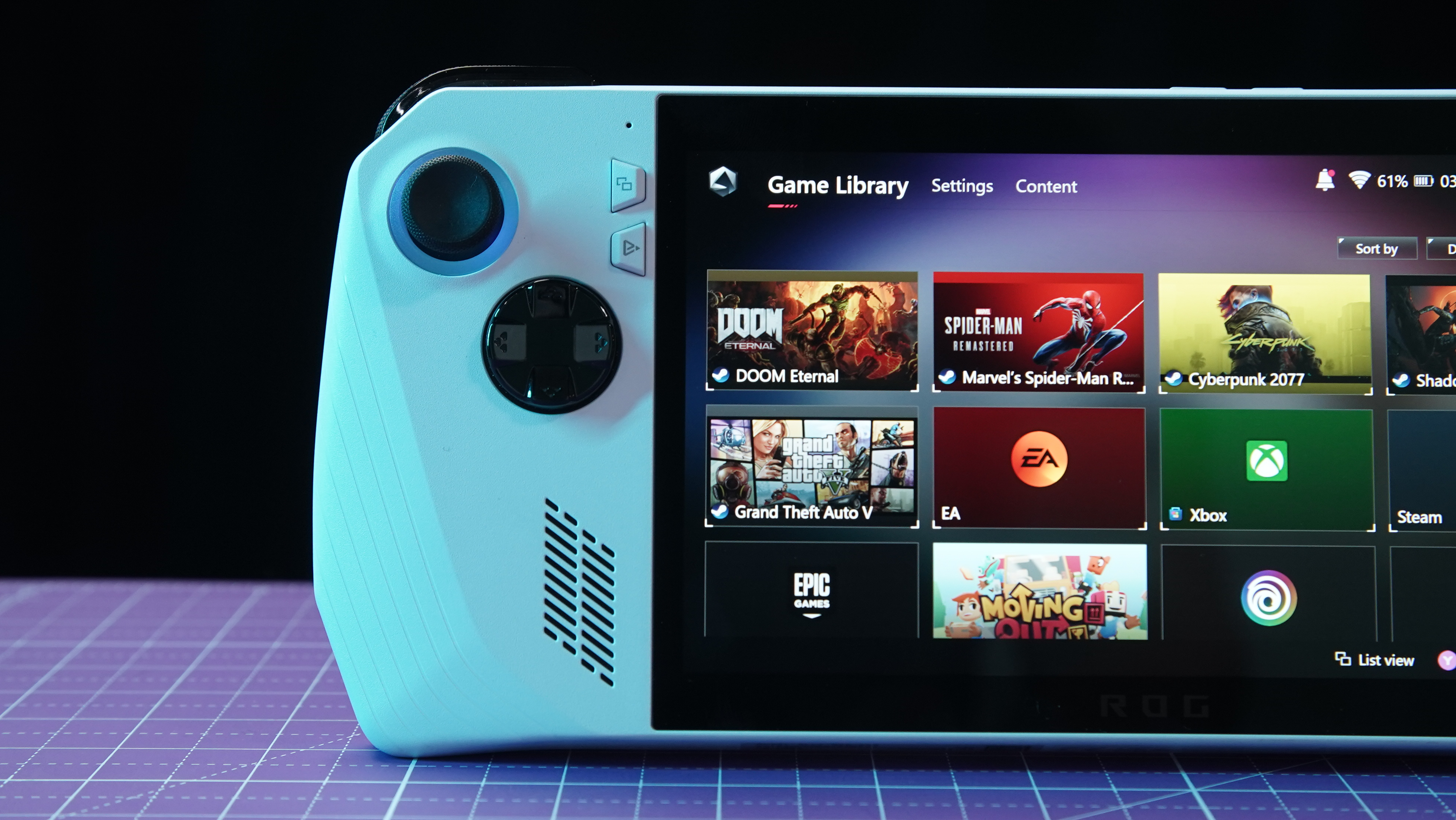
The controller grips on the back of the Ally make it easy to hold for long periods, though I still prefer the Steam Deck’s more comfortable thicker grips. The analog sticks are looser than I’d like but that wasn’t an impediment when playing. I liked using the four large face buttons, which have a nice level of resistance when pressed. In fact, I prefer these face buttons over the Steam Deck’s tiny ones.
I’m somewhat ambivalent about the shoulder and back buttons. They’re responsive enough, but their relatively small size can make them cumbersome to use — especially the two back buttons, which are basically two nubs. With that said, the shoulder buttons have a grill-like texture that makes them easy to press and hold.
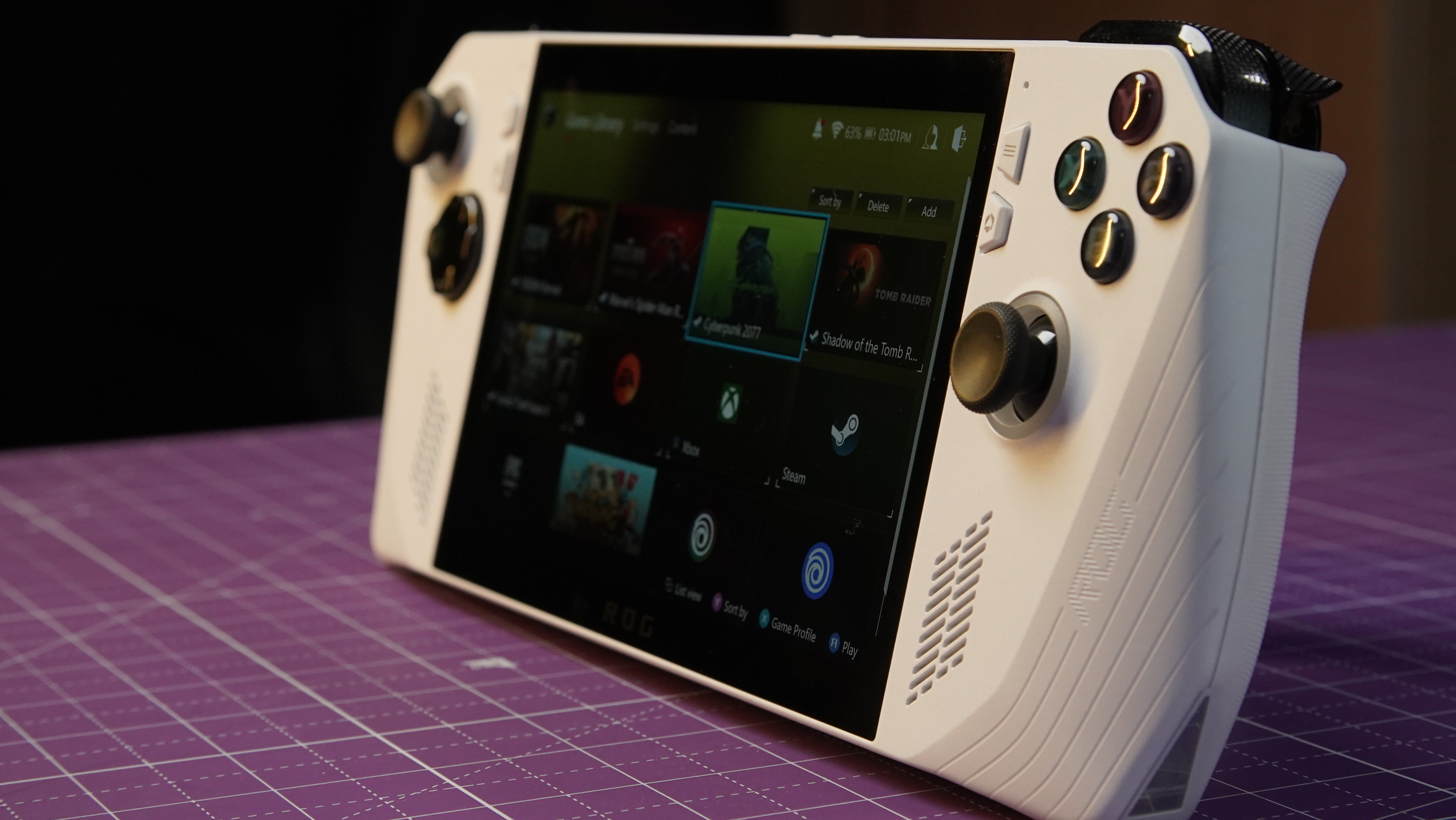
Thankfully, my gripes with the buttons didn’t mar the overall playing experience. Swinging across New York City in Spider-Man or blasting demons away in Doom Eternal felt as intuitive and precise on the Ally as with a game controller. No matter what you play, you shouldn’t face any major issues with the controls.
The display’s touch controls also work well, which is expected given how Windows 11 is such a touch-friendly operating system. However, he controller doesn’t always work as intended (or at all) when using certain apps. In instances like that, you’ll be grateful you can use touch controls to navigate the desktop or applications.
Asus ROG Ally review: Software
- Windows 11 comes pre-installed
- Armoury Crate app gathers installed games
The ROG Ally runs on Windows 11. Because of that, you’re able to run any game or program that’s Windows-compatible right out of the box. This is one of the Ally’s major selling points since the handheld is effectively a small Windows PC. However, this same strength also presents a weakness.
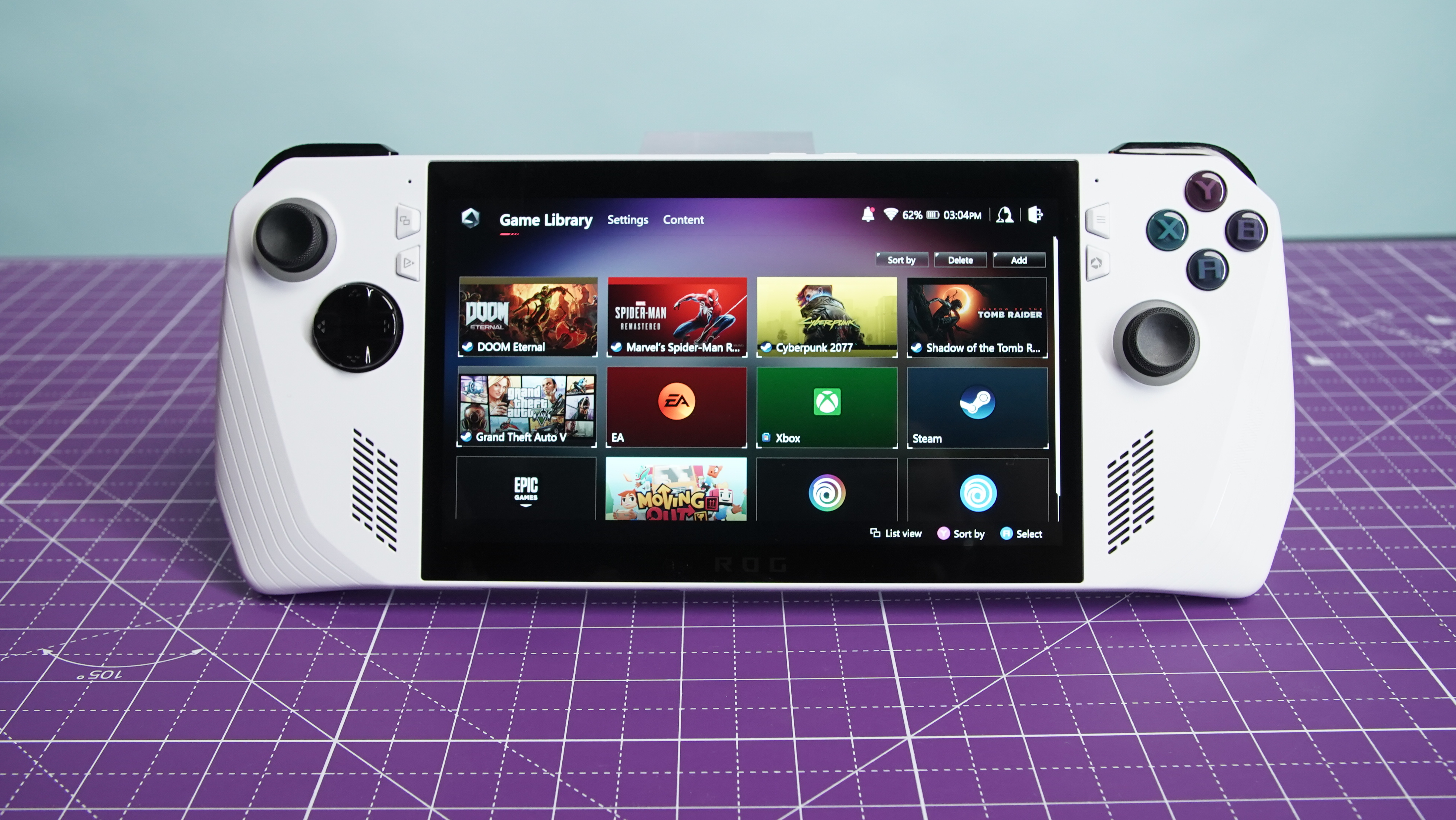
The Steam Deck runs on SteamOS, which has a dedicated controller-friendly UI that’s easy to navigate. Asus’ Armoury Crate app is the Ally’s closest equivalent, but it’s not nearly as intuitive to use. Armoury Crate lets you see and select all the games you’ve downloaded, regardless of their respective launchers. The app itself works as intended, however, once you select a title, you’re then forced to use its associated launcher.
For instance, selecting a Steam game brings up the Steam desktop app. Clicking on an Xbox game pulls up the Xbox app. With the exception of Steam which has a controller-friendly Big Picture mode, you’ll be forced to use the right analog stick as a mouse or use touch controls to navigate these launchers since they don’t recognize the Ally’s controller buttons.
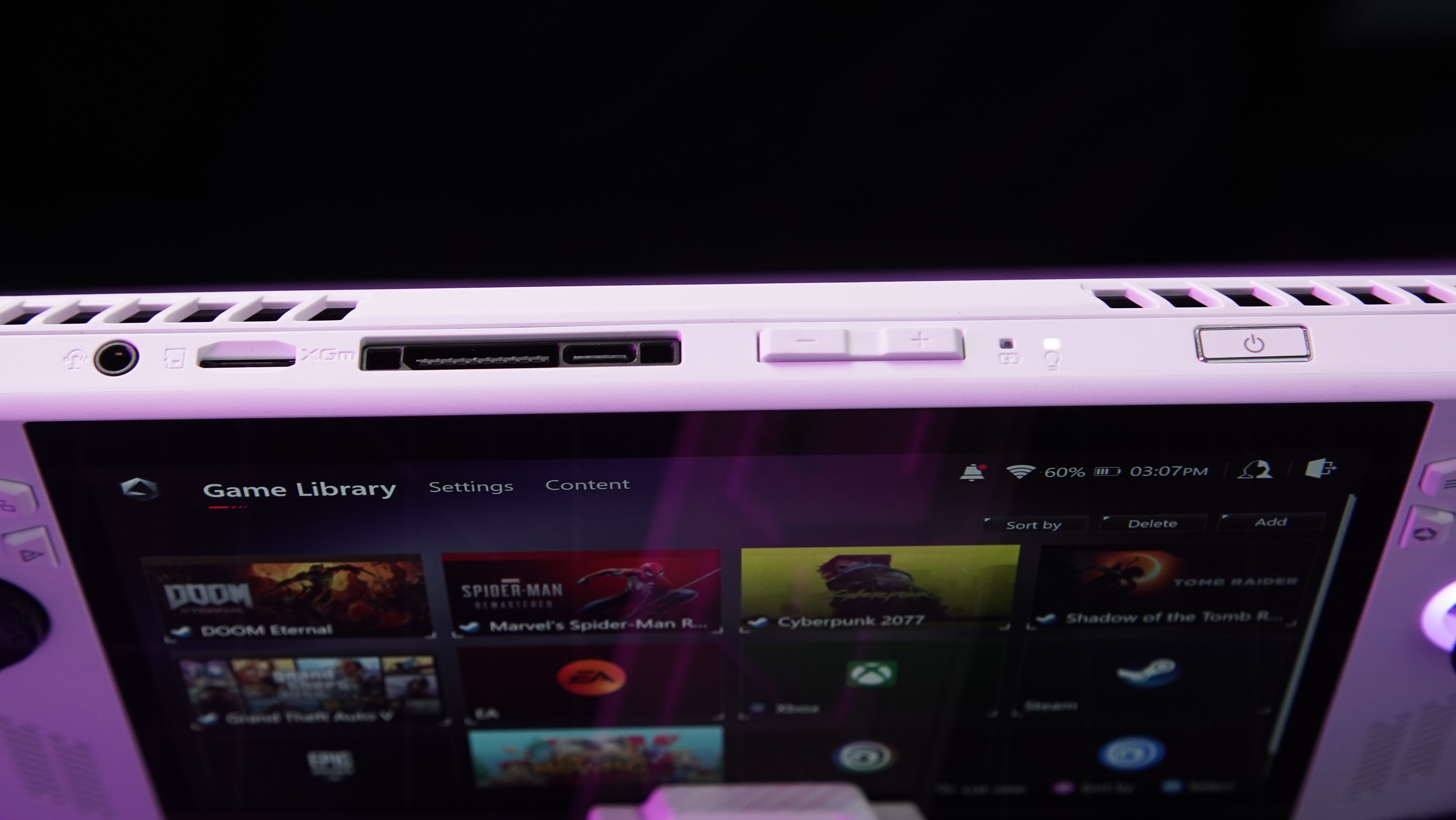
I should note that the Windows desktop offers limited controller support. You’re able to use the d-pad to cycle through items on the desktop and can do the same when navigating through Windows settings. You can press the A button to open selected items on the desktop but can’t do the same in settings; forcing you to use the right analog stick. Granted, none of this feels too clunky in action but it’s certainly not as seamless as navigating through the streamlined SteamOS UI.
Asus ROG Ally review: Game library
- Supports Windows-compatible games
As a Windows 11 device, you can install games from a wide range of launchers, including (but not limited to) Steam, GOG, Ubisoft Connect, Xbox Game Pass, EA Origin and many others. This gives you access to thousands of the best PC games. And as I said above, all of your games get sorted in the Armoury Crate app.
In short, the system’s game library consists of the titles you already own — which is also one of the Steam Deck’s selling points. It’s possible some games may not run well (or at all) on the ROG Ally, so there might be some trial and error involved.
Asus ROG Ally review: Battery life and heat
- Poor battery life
- Runs hot when gaming
Let’s cut to the chase: the ROG Ally doesn’t have great battery life.
In our battery test, which involves continuous web surfing at 150 nits of screen brightness, the ROG Ally lasted for 5 hours and 51 minutes. That’s not terrible if you intend to just browse the web, but this is a gaming device first and foremost.
When we ran the more graphically-demanding PCMark 10 benchmark to simulate how long the Ally would last while gaming, the time dropped to 1 hour and 43 minutes. This corresponds to the battery life I experienced during my own qualitative testing. As you can see in the tablet above, the Ally outlasted the Steam Deck by three minutes in the same PCMark 10 test. Considering how Asus claimed 8 hours of battery life, the real-world results are disappointing.
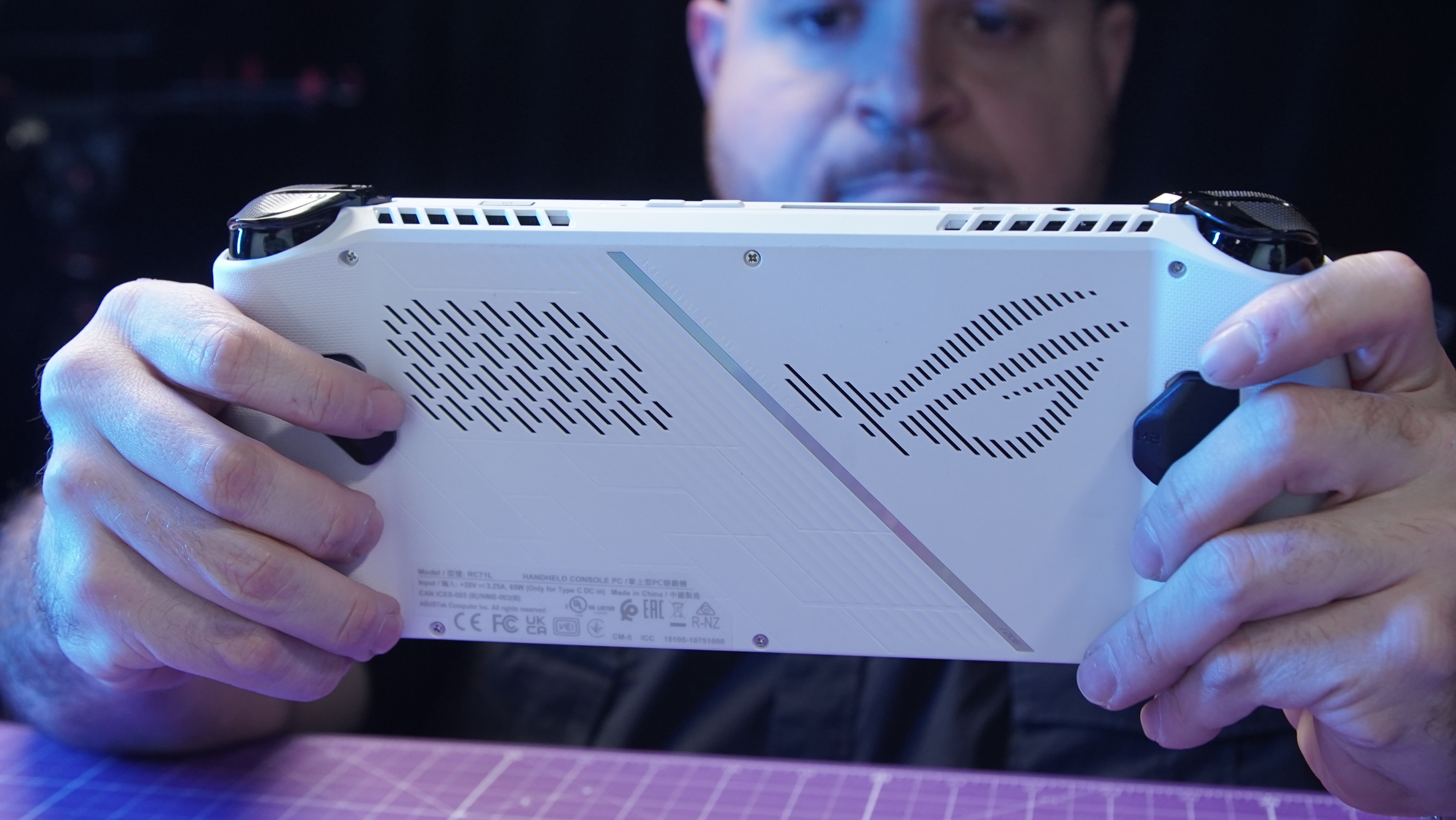
How hot does ROG Ally get? In our standard heat test, which involves playing an HD video for 15 minutes, then scanning the device with a heat gun, we found Asus’ handheld got as warm as 86.5 degrees on the underside, peaking at 95 degrees on the screen.
Those temperatures aren’t bad as we generally consider temperatures over 95 degrees as being uncomfortable. Things really heat up when playing games, with the screen reaching 111 degrees and the top of the handheld peaking at 115 degrees. Thankfully, heat isn’t much of an issue when playing since your hand isn’t resting near any of the vents.
Asus ROG Ally review: Verdict
On its own, the Asus ROG Ally is a great Windows 11 handheld. It has a gorgeous display, feels fantastic to hold and gives you access to your PC gaming library. Though I expected better performance, playing modern titles at moderate to high frame rates on such a small device is impressive. If you’ve never played PC games on a handheld, you’ll be blown away by what Asus’ machine offers.
With that said, the Steam Deck is still an overall better handheld than the ROG Ally. Valve’s device isn’t as cutting-edge as the Ally, but it provides a smoother experience thanks to its easy-to-use SteamOS User Interface. And at time of writing, the Steam Deck also offers better game optimization. There are no Asus ROG Ally “verified games” specifically optimized for the system. In this way, the Steam Deck is better suited to being a gaming handheld, whereas the ROG Ally is a Windows PC with spotty controller support and no dedicated UI for games.
Asus said it plans to iterate on the ROG Ally. If that’s the case, this handheld is a decent starting point to build on. Perhaps a future ROG Ally can match or surpass the Steam Deck. But for now, Valve’s handheld is the superior product.







